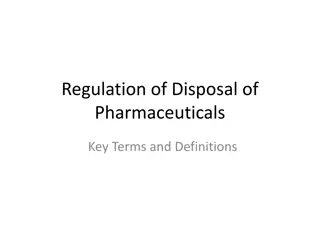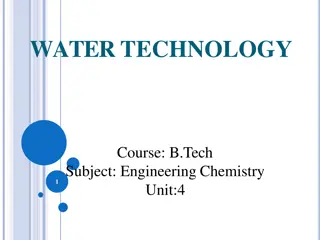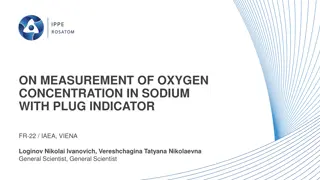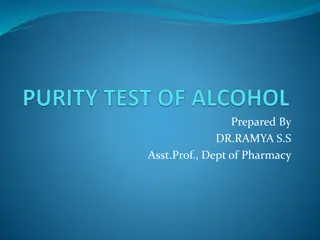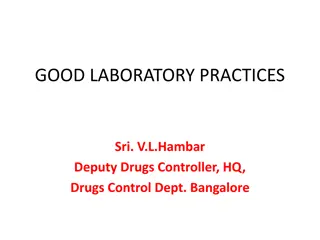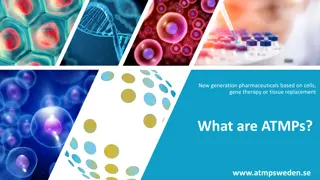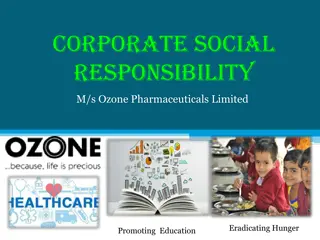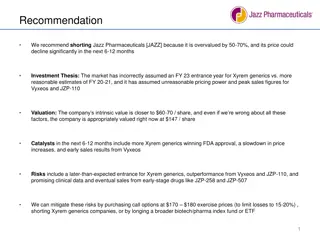Understanding Impurities in Pharmaceuticals: Sources, Classification, and Impact
Impurities in pharmaceutical products are unwanted chemicals that can affect quality, safety, and efficacy. This article discusses the definition of impurities, their distinction from contaminants, major sources, and types. It covers organic, inorganic, and other impurities, as well as limit tests for assessing impurity levels in pharmaceuticals.
Download Presentation

Please find below an Image/Link to download the presentation.
The content on the website is provided AS IS for your information and personal use only. It may not be sold, licensed, or shared on other websites without obtaining consent from the author. Download presentation by click this link. If you encounter any issues during the download, it is possible that the publisher has removed the file from their server.
E N D
Presentation Transcript
PHCH 402: Analytical Quality Control 05: Limit tests (10 hrs)
OUTLINE Presence of impurities in pharmaceuticals and their sources. Limit tests and factors considered in their design, negative and comparison tests. Classification of limit tests: limits of soluble and insoluble matter; moisture; volatile matter; residual solvents; nonvolatile matter. Residue on ignition, loss on ignition, loss on drying, ash values, limit tests for metallic and non-metallic impurities, other specific limit tests
Is there any difference between IMPURITY and CONTAMINANT ?
Definition of Impurities: Impurities in a pharmaceutical product may be defined as unwanted chemicals in the product that are not the active pharmaceutical ingredient (API) itself (or the excipients used to manufacture it), or which develop during formulation or upon aging of both API and formulation. They are unwanted chemicals that remain within the formulation or API in small amounts and which can influence quality, safety and efficacy (QSE), thereby causing serious health hazard.
In general. Impurities substances that occur commonly or naturally in a substance, thereby lowering its quality or value. Depending on its quantity, the impurity may or may not make the substance unfit for its intended use. On the contrary, a contaminant is an external agent that is (or gets) added to something and usually renders it unfit for its intended use. are undesirable elements or
Sources of Impurities Major sources of impurities may be classified broadly into two: i) Synthesis related impurities Raw materials employed the manufacturing process solvent reaction vessel stability of the final product which can be predicted from its chemistry i.e. degradation
Sources of Impurities. ii) Formulation related impurities Physical contamination Improper storage conditions Atmospheric contaminant Microbial contamination Particulate contamination Filth
Types of Impurities According to the International Conference on Harmonisation of Technical Requirements for Registration of Pharmaceuticals for Human Use (ICH), impurities can be classified broadly into: a) Organic impurities b) Inorganic impurities and c) Residual Solvents
I. Synthesis related impurities: A. Organic Impurities: The composition of impurities allows one to draw conclusions regarding the manufacturing of the products and its adulteration. Majority of the impurities are characteristics of the synthetic route of the manufacturing process. Since there are several possibilities of synthesizing a drug, it is possible that the same product of different sources may give rise to different impurities
Synthesis related impurities: In the case of drugs prepared by multi-step synthesis, the number and the variety of structures of organic impurities are almost unlimited and highly dependent on the route and reaction conditions of the syntheses and several other factors such as the purity of the starting material, method of isolation, purification, conditions of storage etc.
1. Starting Materials and Intermediates: Starting materials and intermediates are the chemical building blocks used to construct the final form of a drug substance molecule. Unreacted starting materials and intermediates, particularly those involved in the last a few steps of the synthesis, can potentially survive the synthetic and purification process and appear in the final product as impurities For example, in the synthesis of paracetamol, p- aminophenol could be a starting material or an intermediate and may appear in the final product. There is a limit test for it in bulk paracetamol:
Production of paracetamol from intermediate p-amino phenol:
Impurities in the Starting Materials: Impurities present in the starting materials could be present in the final product, or follow the same reaction pathways as the starting material itself, and the reaction products could carry over to the final product as process impurities. Knowledge of the impurities in starting materials helps to identify related impurities in the final product, and to understand the formation mechanisms of these related process impurities e.g i.
Effect of trace impurity in starting material: Tolperisone trace impurity Starting material trace impurity
ii. Degradation products during manufacturing During manufacturing of bulk drugs degradation of end products results in the formation of impurities. For example Hydrochlorothiazide has a known degradation pathway through which it degrades to the starting material as 1,3- disulfonamide in its synthesis:
Dihydrochlorothiazide degradation: Dihydrochloro thiazide degradation product
iii. By products: In synthetic organic chemistry, getting a single end product with 100% yield is seldom. There is always a chance of having by-products. can be formed through variety of side reactions, such as incomplete reaction, over-reaction, isomerization, dimerization, rearrangement or unwanted reactions between starting materials or intermediate with chemical reagents or catalysts . For example, in the case of paracetamol bulk production, diacetylated paracetamol may form as a by-product :
Formation of diacetylated paracetamol as a by-product:
iv. Organic Reagents, Ligands and Catalysts: Chemical reagents, ligands, and catalysts used in the synthesis of a drug substance can be carried over to the final products as trace level impurities. For example, carbonic acid chloromethyl tetrahydro-pyran-4-yl ester (CCMTHP), which is used as an alkylating agent in the synthesis of a beta-lactam drug substance, was observed in the final product as an impurity Pyridine, a catalyst used in the course of synthesis of mazipredone, reacts with an intermediate to form a pyridinium impurity
v. Organic Impurities originating from reaction solvents: Impurities in the solvents can also be source of impurities. For e.g. 2-hydroxytetrahydrofuran is an impurity in tetrahydrofuran, which is often used as the solvent of Grignard reagents furan: 2-hydroxytetrahydrofuran:
B: Inorganic impurities Inorganic impurities derive from the manufacturing process for the bulk drug, and excipients. They include the following: 1. Reagents, ligands, and catalysts The chances of having these impurities are rare: however, in some processes, these could create a problem unless the manufacturers take proper care during production.
2. Heavy metals The main sources of heavy metals are: a) the water used in the processes and the reactors (if stainless steel reactors are used), where acidification or acid hydrolysis takes place. These heavy metal impurities can easily be avoided using demineralized water and glass-lined reactors.
b) Excipients: Generally, excipients may contain high levels of heavy metals such as arsenic, bismuth, cadmium, chromium, copper, iron, lead, mercury, nickel and sodium. Sometimes they might present in the product during processing or may leach from packing material. For example, excipients such as hydrogenated oils and fats, which are produced using metal catalysts, are found to contain high concentrations of metals (platinum and palladium). This may be due to leaching from process equipment or storage container.
3. Other materials (e.g., filter aids, charcoal etc.) filters or filtering aids such as centrifuge bags are routinely used in the bulk drugs manufacturing plants and in many cases, activated carbon is also used. The regular monitoring of fibers and black particles in the bulk drugs is essential to avoid these contaminations.
C. Residual solvents Residual solvents are volatile organic chemicals used during the manufacturing process or generated during production Residual solvents are potentially undesirable substances. either modify the properties of certain compounds or may be hazardous to human health.
Also affect physicochemical properties of the bulk drug substances such as crystallinity, which in turn may affect the dissolution properties, odor and colour changes in finished products In addition, solvents used in synthesis may contain a number of impurities which can react with chemicals used in the synthesis to produce impurities
Water: Most commonly used solvent Not considered as an impurity most of the time However moisture content can be very important after packaging as moisture content may be sufficient to cause hydrolysis Drug products may also be affected by water from environment Hydrolysis due to presence of water causes chemical instability problems Water can be present even in non-aqueous formulations in enough quantities to cause degradation It can also be a major source of microbial contamination
II. FORMULATION RELATED IMPURITIES A. DOSAGE FORM RELATED (EXCIPIENTS): APIs are formulated with excipients (pharmaceutical aids) into solutions, tablets, capsules, semi-solids, aerosols and Novel Drug Delivery Systems. During formulation, excipients are added to API to render the product elegant. They can be sometimes heterogeneous mixtures. i. Excipients can be a source impurities and microbial contamination ii. drug excipient incompatibility may lead to undesirable products which can affect the therapeutic efficacy of the product eg: See table below
Effect of Pharmaceutical Aids on Stability of Active Ingredients Active ingredient Pharamaceutical aid Effect Kanamycin Honey, sugar syrup Loss of activity at room temperature (RT) Cholecalciferol 2%polyoxy ethylene ester surfactant, polysorbate Change in pH resulted, degradation of active ingredient Tetracyclines Calcium or magnesium or metal ions Complexation Thiomersal Bromine, chloride, iodide Form different soluble halides of cationic mercury compounds. Adrenaline Boric acid, povidone Stabilization Tryptophan Sodium pyrosulfite, oxygen Discoloration, precipitation.
In general Liquid dosage forms may undergo both degradation as well as microbial contamination Water content, pH of formulation, compatibility of cations and anions, mutual interaction of ingredients and the primary container are the critical factors
B. METHOD RELATED IMPURITY Eg. In production of parenteral dosage form of diclofenac Na, 1-(2,6 dichlorophenyl) indoline- 2 one is formed as an impurity when it is terminally sterilised by autoclaving. The formation of this derivative and NaOH occurs due to intramolecular cyclic reaction of diclofenac Na by autoclave conditions (1230C).
Diclofenac Na Indolinone derivative
C. Environmental related impurity 1. Temperature: Especially during formulation of vitamins and antibiotics, extreme care should be exercised to prevent them from degradation because these classes of compounds are heat liable. When subjected to extreme temperature, loss of potency takes place (for instance drying under heat)
2. Light - UV light: Light is one of the means by which the formulation degrades because of photolytic reaction. Exposure to light is known to be deleterious on a number of pharmaceutical compounds. For eg. Ergometrine injection has been reported to be unstable under tropical conditions of light and heat. Some other drugs that are affected are:
3. Humidity Humidity is one of the important key factors incase of hygroscopic compounds. It is detrimental to both bulk powder and formulated solid dosage form. The classic examples are ranitidine and aspirin
D. Impurities on Aging (storage and transport) 1. Mutual interaction amongst ingredients Because of the labile nature of vitamins, they undergo degradation in different dosage forms, especially liquid degradation of vitamins such as folic acid, thiamine and cyanocobalamines does not yield toxic impurities but they lose their potency well below compendial specifications An example of mutual interaction : presence of nicotinamide in formulation containing four vitamins (nicotinamide, pyridoxine, riboflavin and thiamine) causes the degradation of thiamine to a substandard level within a one year shelf life of vitamin B complex injection .
2. Instability of the Product Chemical instability Impurities can also arise during storage because of chemical instability of the pharmaceutical substance. Many pharmaceutically important substances undergo chemical decomposition when storage conditions are inadequate. often catalyzed by light, traces of acid or alkali, traces of metallic impurities, air oxidation, carbon dioxide and water vapours (humidity) The nature of the decomposition can easily be predicted from the knowledge of chemical properties of the substance(s) All such decompositions can be minimized or avoided by using proper storage procedures and conditions The photosensitive substances should be protected from light by storing them in darkened glass or metal containers thereby inhibiting photochemical decomposition. Materials susceptible to oxidation by air or attack by moisture should be stored in sealed containers if necessary the air from the containers can be displaced by an inert gas such as Nitrogen. Oxidation can also be prevented by adding suitable antioxidants a.
Types of degradation i. Oxidation Drugs which are prone to oxidation are those that contain OH groups directly bonded to aromatic rings eg. catechols, conjugated-dienes, heterocyclic aromatic rings, nitroso and nitrite derivatives e.g. Hydrocortisone, methotrexate, adinazolam, catecholamine, (Vitamin A) etc. In pharmaceuticals, the most common form of oxidative decomposition is auto oxidation through a free radical chain process commonly catalysed by metals. For example, auto-oxidation of ascorbic acid studies reveals that cupric ion oxidises ascorbic acid rapidly to dehydroascorbic acid and potassium cyanide. As a result, there is a cleavage of chain due to the formation of copper complexes.
ii. Hydrolysis A reaction in which water is the reactant causing precipitation. Most well-known examples of such reactions in pharmaceutical compounds are esters and amides Many drugs are derivatives of carboxylic acids or contain functional groups based on that moiety example esters, amides, lactones, lactams, imides and carbamates, others which are susceptible to acid-base hydrolysis include aspirin, atropine, chloramphenicol, barbiturates, chlordiazepoxide, oxazepam and lincomycin etc.
iii. Decarboxylation Some of the carboxylic acids such as p-amino salicylic acid have shown loss of carbon dioxide from carboxyl group when heated For instance, photo reaction of rufloxacin tablet enteric coated with cellulose acetate phthalate (CAP) and sub-coating with calcium carbonate cause hydrolysis of CAP liberating acetic acid, which on reacting with calcium carbonate produced carbon dioxide, a by-product that blew off the cap from the bottle after cap was loosened .
iv. Photolysis Photolytic cleavage on aging includes examples of pharmaceutical drugs or products that are prone to degradation on exposure to UV-light During manufacturing process as solid or solution, packaging or on storage, drugs like ergometrine, nifedipine, nitroprusside, riboflavin and phenothiazines are liable to photo oxidation involves generation of free radical intermediate, which will degrade the products For example, exposure of ciprofloxacin eye drop 0.3% to UV light induces photolysis thereby resulting in the formation of ethylene di-amine analogue of ciprofloxacin
b. Physical instability Pharmaceuticals may undergo changes in physical properties during storage. There can be changes in crystal size and shape, sedimentation, agglomeration and caking of the suspended particles. These physical changes are not always avoidable and may result in significant changes in the physical appearance, pharmaceutical and therapeutic effects of the product. Particle size and consequently surface area is a critical factor in determining the bioavailability of the low solubility drug such as griseofulvin. Physical changes such as sedimentation and caking in case of multidose suspension may constitute hazard leading to the possibility of under dosage and later to overdosage of the drugs. Similarly increase in the globule size of the injectable emulsions on storage may lead to fat embolism.
E) Packaging material Impurities result also from packaging materials i.e., containers and closures For most drugs the reactive species for impurities consists of: Water hydrolysis of active ingredient. Small electrophiles Aldehydes and carboxylic acid derivatives. Peroxides oxidize some drugs. Metals catalyze oxidation of drugs and their degradation pathway. Extractable or leachables Emerge from glass, rubber stoppers and plastic materials, in which oxides like NO, SiO, CaO, MgO are major components leached or extracted from glass. Some examples of synthetic materials include styrene from polystyrene, diethylhexylpthalate (DEHP) plasticizer in PVC, dioctyltin iso octyl mercaptoacetate stabilizer for PVC, zinc stearate stabilizer in PVC and polypropylene, bisphenol A from plastics etc.
Enantiomeric Impurities: The majority of therapeutic chiral drugs used as pure enantiomers are natural products. The high level of enantioselectivity of their biosyntheses excludes the possibility of the presence of enantiomeric impurities In the case of synthetic chiral drugs, the racemate of which is usually marketed, if the pure enantiomer is administered, the antipode is considered to be an impurity. The reason for its presence can be either a) the incomplete enantioselectivity of the syntheses or b) incomplete resolution of the enantiomers of the racemate Although the ICH guideline excludes enantiomeric impurities, pharmacopoeias consider them as ordinary impurities
A single enantiomeric form of chiral drug is now considered as an improved chemical entity that may offer a better pharmacological profile and an increased therapeutic index with a more favourable adverse reaction profile than the racemic mixture; and a lower dose However, the pharmacokinetic profile of levofloxacin (S- Isomeric form) and ofloxacin (R-isomeric form) are comparable, suggesting the lack of advantages of single isomer in this regard Typical examples of drugs containing enantiomeric impurities: a) Dexchlorophenarmine maleate (R enantiomer impurity allowed NMT 0.5%) b) Timolol maleate (R enantiomer impurity allowed NMT 1%) c) Clopidogrel sulphate (R enantiomer impurity allowed NMT 1%) In general, an individual API may contain all of the above- mentioned types of organic impurities at levels varying from negligible to significant
Pharmacopoeial Norms for the Enantiomeric Impurities: Many medicinal substances that contain one or more chiral centres and that are already in the market have been made available for pharmaceutical use as racemic mixtures with little known about the biological activities of the separate isomers and this is reflected in the monograph in the pharmacopoeia. Nevertheless, with increasing concern by regulatory authorities for substances to be made available as single isomers, tests for enantiomeric composition will become more common As a result the following recommendations have been made by the BP 2001:
Chemical definition in monographs 1) -In the case of substances containing a single chiral centre, the descriptor (RS) should be included at the appropriate position in the chemical definition of the substances to indicate a racemic mixture. 2) - For substances containing multiple chiral centres and comprising mixture of all possible stereomers the term all-rec should be used, for example Iso-aminile. In those few substances existing as diastereomeric mixtures, that is where in one or more centres the stereochemistry is explicit but in other centres it is not, each centre is defined either as the specific (R)- or (S) configuration , or as racemic (RS)-, respectively.
In future Tests: 1) - when a monograph describes an enantiomer, it will include both a test for specific optical rotation under identification and a test using methods such as chiral chromatography, to control enantiomeric purity. 2) - When only the racemic mixture is available, the monograph for the racemic mixture will simply specify a test for angle of rotation.



